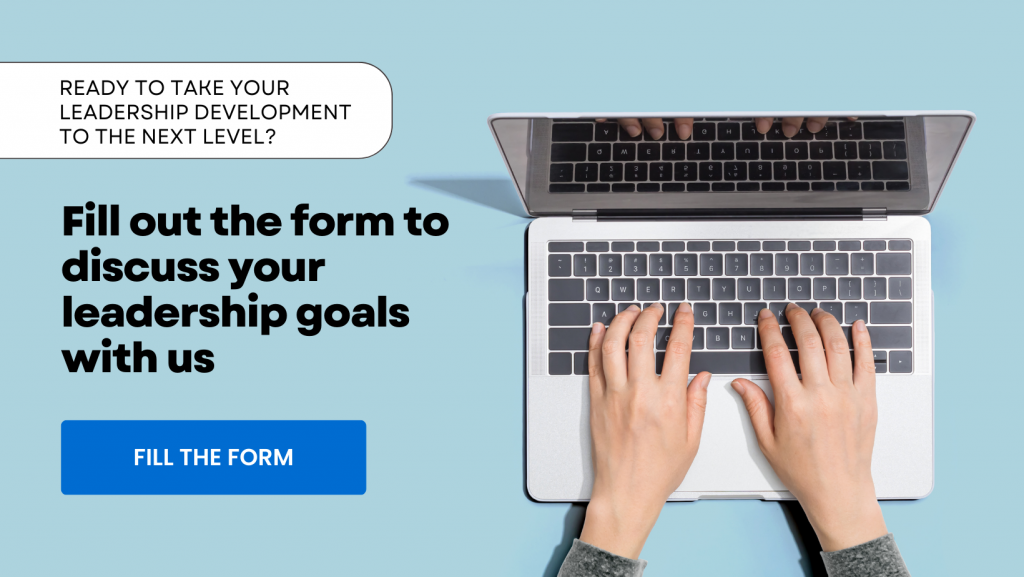3 Steps to Define Leadership Training Needs8 min read
Reading Time: 6 minutesReading Time: 6 minutesIn a business environment that’s constantly in flux, molding effective leaders is critical for organizations vying to thrive. Leaders inspire teams, steer innovation, and exhibit resilience amid challenges. A growing understanding of leadership’s potent impact on organizational success has led companies to invest in cultivating their leadership talent pool. In the article, we’ll examine how to pinpoint leadership training needs and devise a plan to bolster leadership skills. So, ready to embark on an exploratory journey to unlock leadership potential in your organization? Let’s dive in.
1. Define desired leadership traits and skills

Align leadership development with organizational goals
Effective leadership development is inseparable from an organization’s broader objectives and strategies. First, scrutinize the company’s mission statement, as it often gives a bird’s-eye view of the organization’s key objectives. Review the company’s strategic plans, which tend to encapsulate specific aims the company is pursuing. Exploring Key Performance Indicators (KPIs) can be enlightening, as they illustrate the degree to which a company is accomplishing its pivotal business objectives. Lastly, engage managers or executives in conversation to comprehend their current focuses. Stay alert during all-hands meetings, departmental discussions, or team gatherings where executives share updates and future strategies.
One valuable exercise is to articulate these goals to a child. If the child grasps them, it suggests the goals are lucid and succinct. Conversely, if the child wrestles with understanding them, it may signal a need for further refinement.
Identify key leadership qualities for success
Organizations each cherish a unique set of leadership qualities that are instrumental in driving success. Such qualities might encompass effective communication, strategic thinking, adaptability, empathy, integrity, resilience, and the capacity to motivate and inspire others. A few strategic methods can help organizations accurately pinpoint these crucial leadership qualities.
Analyze successful teams
Examine teams that have successfully achieved similar goals, both inside and outside your organization. This process involves reviewing the team’s strategies, communication style, decision-making processes, and their approach to problem-solving. This allows you to identify common leadership qualities. However, remember to consider the specific context and circumstances of these teams’ success to avoid falsely attributing results.
Adopt holistic approach
When analyzing teams’ success and what traits led to this success, ensure you look at various synergies and interplay between various parts of your organization. One team’s success could be attributed to its leaders’ qualities, to other teams’ input or even to external factors and organizations. Modern day organizations try to reduce silo cultures – learning organizations should be the first to follow suit and build leadership development strategies accordingly.
Seek input
Collect feedback from team members, stakeholders, and other organizational leaders. Surveys, interviews, or casual conversations can offer valuable insights. Be mindful that this process may yield diverse opinions, reflecting the variety of perspectives within your organization.
Consider future challenges
Forecast potential hurdles your team may encounter in striving towards these goals. This might involve scenario planning, risk analysis, or discussions about potential future industry trends. This could inform the essential leadership qualities. However, keep in mind that future projections come with inherent uncertainty, warranting regular revisits and updates of your analysis.
By defining the desired leadership traits and skills, organizations chart a clear course for leadership development. This creates an aligned, cohesive approach to leadership that drives organizational success and contributes to a healthy leadership culture.
2. Evaluate existing leadership skills and competencies

Effective leadership development begins with an exhaustive assessment of the organization’s current leadership landscape. This involves a comprehensive evaluation of the existing leadership skills and competencies. Such an objective analysis can spotlight areas that need enhancement and inform targeted development initiatives.
Select appropriate assessment tools for training nee
Choose the assessment tools that will accurately depict your organization’s leadership development landscape. Surveys, interviews, and performance reviews each offer distinct advantages that, combined, yield a comprehensive evaluation of current leadership capabilities.
Surveys
Surveys are structured tools for collecting feedback from a large group. They can promote anonymity and encourage candid responses. Delivered electronically, they can promote anonymity and elicit candid responses. Surveys can be designed with both closed-ended questions (participants choose from predefined options) and open-ended questions (participants provide detailed answers). Analyzing the responses can help detect recurring themes, trends, and areas that need attention.
Interviews
Interviews, whether conducted one-on-one or in small groups, offer a platform for in-depth discussions with individuals in leadership roles. Interviews offer organizations the ability to understand the specific challenges, skill gaps, and development opportunities that leaders face. This method is also valuable for employees as it provides an opportunity for personal expression and direct dialogue with the organization.
Performance reviews
Performance reviews are a structured method for evaluating leadership competencies and pinpointing areas for improvement. They allow organizations to assess leaders’ current skill sets, behavioral patterns, and alignment with organizational goals. For employees, performance reviews provide an opportunity to receive constructive feedback and understand their progression within the company. Nowadays, one has numerous opportunities to adapt assessment tools to the unique needs via modern technologies. For instance, AI can play a significant role in performance reviews by offering advanced data analysis capabilities. This could include tracking performance metrics over time, identifying behavioral trends, or predicting future performance based on historical data.
The integration of surveys, interviews, and performance reviews into the assessment process ensures a multi-faceted understanding of leadership development needs. Surveys offer a broader, quantitative perspective, while interviews provide qualitative depth and personalized insights. Performance reviews, on the other hand, help evaluate existing leadership capabilities. Together, these tools offer a comprehensive understanding of the leadership landscape, enabling organizations to design training programs that effectively address the identified needs. For employees, participation in these assessments can promote a sense of ownership and involvement in their own development, leading to increased engagement and job satisfaction.
Identify skill gaps through the holistic approach
Identifying skills gaps involves analyzing both existing competencies and the desired leadership qualities. This process requires organizations to juxtapose the current leadership skill sets with those required for effectively achieving organizational goals. Such comparative analysis helps to determine the specific competencies or behaviors that need refinement, illuminating the areas of discrepancy between the current abilities and those essential for organizational success.
The process for identifying these gaps includes a blend of strategic methodologies. Start with a self-assessment test, a tool that prompts individuals to reflect on and evaluate their own skills and competencies. This tool can bring to light areas in which the individual feels proficient and areas in which they believe improvement is necessary.
Following the self-assessment, evaluations conducted by senior leaders or peers can offer an external perspective on performance. These are evaluations designed usually in the form of surveys that are structured to provide constructive feedback, highlighting strengths and pinpointing areas for development. They can expose any gaps that may not be obvious to the individual, providing a more rounded view of their skills.
Lastly, incorporate structured interviews. These are systematic, preplanned interviews that focus on specific skills and competencies. They allow for more nuanced discussions about an individual’s abilities, further revealing potential gaps that may not be captured by tests and evaluations of the training needs.
Importantly, this holistic process is essential not only for the organization to meet its goals but is also beneficial for the employees themselves. Understanding one’s strengths and areas for improvement can heighten an individual’s motivation and engagement with their work. As employees gain a clearer picture of the tasks they excel at and those they can enhance, they can align their personal growth with the organization’s objectives. This alignment ultimately fosters a more engaged, productive, and fulfilled workforce, driving both personal and organizational success.
3. Identify specific training areas

To maximize the impact of leadership development programs, organizations need to identify specific training areas that align with both technical and soft skills.
Focus on technical and industry-specific skills
Effective leaders require a solid foundation of technical knowledge and industry-specific expertise. Organizations should identify the key technical skills necessary for leadership roles within their specific industry. This may include areas such as financial acumen, project management, or industry-specific regulations. By addressing these technical skill gaps, organizations ensure that their leaders are well-equipped to navigate the complexities of their industry.
Do not forget about soft skills and emotional intelligence
Soft skills, such as communication, teamwork, and emotional intelligence, are crucial in successful leadership. As Jack Zenger, CEO of Zenger/Folkman, and Joseph Folkman, its president, emphasize, technical expertise alone is insufficient to sustain leadership effectiveness. They claim: “Having deep knowledge and expertise goes a long way in terms of getting a person noticed and valued. … However, it’s essential to understand that what got you invited to the party is not enough to keep you at the party. People who are skilled technically but lack excellent leadership capabilities need to develop those skills.”
Organizations must recognize the significance of nurturing soft skills and emotional intelligence in their leaders. By providing targeted training and development opportunities that enhance emotional intelligence, conflict resolution, and effective communication, organizations empower their leaders to build strong relationships, inspire their teams, and navigate complex interpersonal dynamics.
Through a comprehensive needs assessment and identification of specific training areas, organizations can develop tailored leadership programs that address the unique challenges and requirements of their workforce. Stay tuned for actionable strategies that will elevate your leadership training initiatives.





